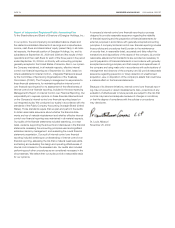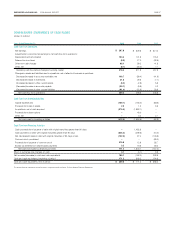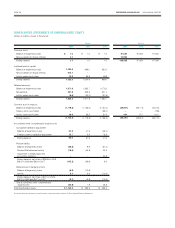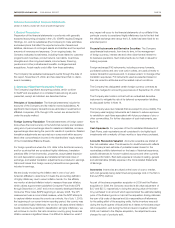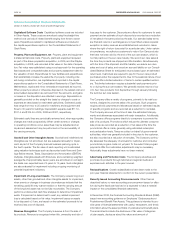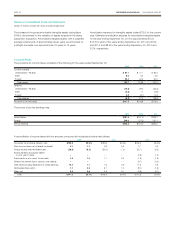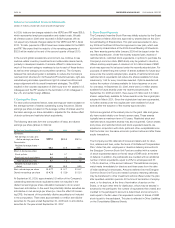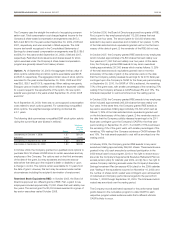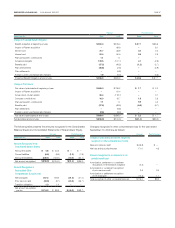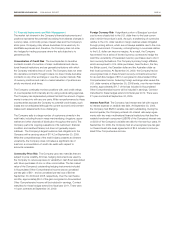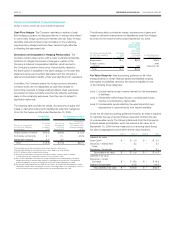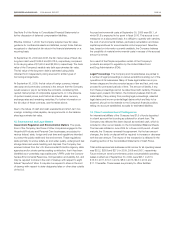Energizer 2009 Annual Report Download - page 35
Download and view the complete annual report
Please find page 35 of the 2009 Energizer annual report below. You can navigate through the pages in the report by either clicking on the pages listed below, or by using the keyword search tool below to find specific information within the annual report.
ENERGIZER HOLDINGS INC. 2009 ANNUAL REPORT PAGE 33
In 2007, $4.3 of tax benefits related to prior years’ losses were
recorded. These benefits related to foreign countries where our sub-
sidiary subsequently began to generate earnings and could reasonably
expect future profitability sufficient to utilize tax loss carryforwards prior
to expiration. Improved profitability in Mexico in 2007 accounted for the
bulk of the benefits recognized.
Adjustments were recorded in each of the three years to revise
previously recorded tax accruals to reflect refinement of tax attribute
estimates to amounts in filed returns and settlement of tax audits in
a number of jurisdictions. Such adjustments increased the income
tax provision by $1.5 and $1.1 in 2009 and 2008, respectively, and
decreased the income tax provision by $7.9 in 2007. Also, legislation
enacted in Germany reduced the tax rate applicable to the Company’s
subsidiaries in Germany for fiscal 2008 and beyond. Thus, an adjust-
ment of $9.7 was made to reduce deferred tax liabilities in fiscal 2007.
The deferred tax assets and deferred tax liabilities recorded on the
balance sheet as of September 30 for the years indicated are as
follows and include current and noncurrent amounts:
2009 2008
Deferred tax liabilities:
Depreciation and property differences $(101.8) $(108.1)
Intangible assets (532.4) (528.4)
Pension plans (30.6) (16.3)
Other tax liabilities (4.7) (16.3)
Gross deferred tax liabilities (669.5) (669.1)
Deferred tax assets:
Accrued liabilities 101.0 119.0
Deferred and stock-related compensation 94.6 89.2
Tax loss carryforwards and tax credits 14.6 15.2
Intangible assets 31.2 32.4
Postretirement benefits other than pensions 6.4 5.4
Pension plans 81.2 12.7
Inventory differences 25.8 23.7
Other tax assets 7.2 10.4
Gross deferred tax assets 362.0 308.0
Valuation allowance (10.3) (9.1)
Net deferred tax liabilities $(317.8) $(370.2)
There were no material tax loss carryforwards that expired in 2009.
Future expirations of tax loss carryforwards and tax credits, if not uti-
lized, are as follows: 2010, $0.2; 2011, $0.7; 2012, $1.1; 2013, $0.4;
thereafter or no expiration, $12.2. The valuation allowance is attributed
to tax loss carryforwards and tax credits outside the U.S.
At September 30, 2009, approximately $760 of foreign subsidiary
retained earnings was considered indefinitely invested in those busi-
nesses. U.S. income taxes have not been provided for such earnings.
It is not practicable to determine the amount of unrecognized deferred
tax liabilities associated with such earnings.
The Company adopted new accounting guidance for accounting for
uncertainty in income taxes on October 1, 2007. At the date of adop-
tion of the new guidance, the Company had $34.5 of unrecognized
tax benefits in the financial statements, excluding the unrecognized tax
benefit from the Playtex acquisition. Of this amount, the impact
of the cumulative change in accounting principle was immaterial.
Unrecognized tax benefits activity for the years ended September 30,
2009 and 2008 are summarized below:
2009 2008
Unrecognized tax benefits, beginning of year $47.0 $34.5
Additions based on current year
tax positions and acquisitions
3.3 14.3
Reductions for prior year tax positions (1.6) (1.8)
Settlements with taxing authorities (1.8) –
Unrecognized tax benefits, end of year $46.9 $47.0
Included in the unrecognized tax benefits noted above are $42.7 of
uncertain tax positions that would affect the Company’s effective tax
rate, if recognized. The Company does not expect any significant
increases or decreases to their unrecognized tax benefits within twelve
months of this reporting date. In the Consolidated Balance Sheets,
unrecognized tax benefits are classified as other liabilities (non-current)
to the extent that payment is not anticipated within one year.
Prior to the adoption of the new accounting guidance for accounting
for uncertainty in income tax, only interest expense on underpayments
of income taxes was included in the income tax provision. Penalties
were classified as an operating expense in arriving at pre-tax income.
Upon adoption of the new guidance, the Company elected a new
accounting policy, as permitted by this guidance, to also classify
accrued penalties related to unrecognized tax benefits in the income
tax provision. The Company accrued approximately $6.7 of interest
and $0.7 of penalties at September 30, 2009 and $5.8 of interest and
$0.7 of penalties at September 30, 2008 in the income tax provision.
Interest was computed on the difference between the tax position
recognized in accordance with GAAP and the amount previously taken
or expected to be taken in the Company’s tax returns.
The Company files income tax returns in the U.S. federal jurisdiction,
various city, state, and more than 40 foreign jurisdictions where the
Company has operations. U.S. federal income tax returns for tax years
ended September 30, 2003 and after remain subject to examination
by the Internal Revenue Service. With few exceptions, the Company is
no longer subject to state and local income tax examinations for years
before September 30, 2002. The status of international income tax
examinations varies by jurisdiction. The Company does not anticipate
any material adjustments to its financial statements resulting from tax
examinations currently in progress.
6. Restructuring and Related Charges
The Company continually reviews its Household Products and Per-
sonal Care business models to identify potential improvements and
cost savings. In July 2009, the Board of Directors approved a restruc-
turing plan designed primarily to re-organize and reduce headcount
in the Household Products business. The approved plan provided for
an offer of a voluntary enhanced retirement option (VERO) to certain
eligible hourly and salaried U.S. employees, and the elimination of addi-
tional positions as part of a limited involuntary reduction in force (RIF).



